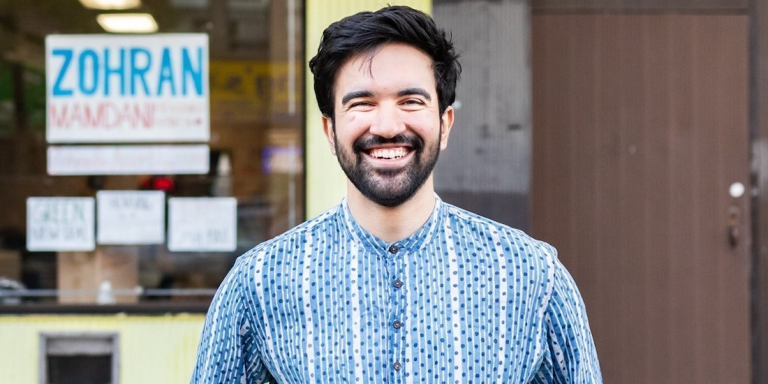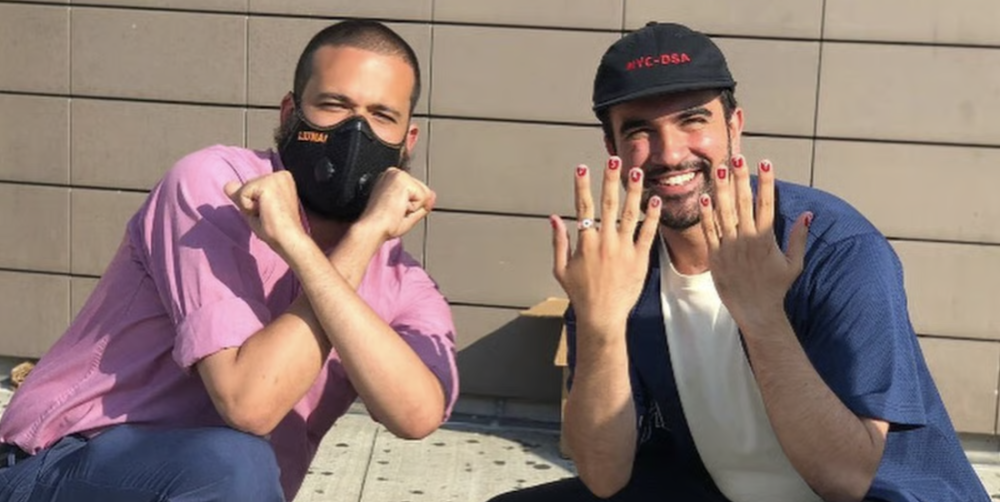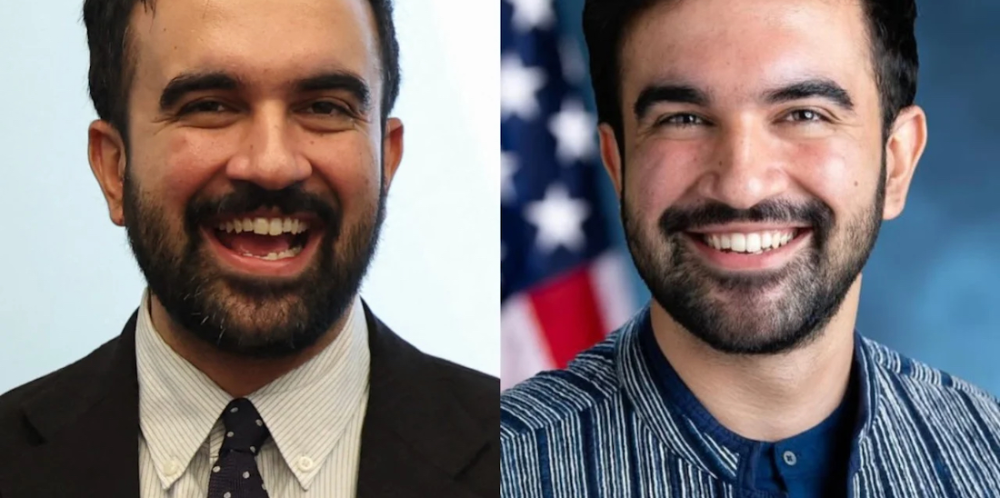
The Democratic Nominee Blends Indian, Ugandan, And New York Streetwear In Campaign For City’s Highest Office
New York, N.Y. – In a political landscape where candidates often dress in uniform navy suits and red ties, Zohran Kwame Mamdani [Luce Index™ score: 95/100] is rewriting the rules of campaign fashion. The 34-year-old New York State Representative and Democratic nominee for New York City mayor has transformed his wardrobe into a platform—one that speaks to his multicultural heritage, his working-class constituency, and his vision for an inclusive city.
A Heritage Woven Into Every Thread
Mamdani’s approach to campaign fashion is deliberate and deeply personal. As the son of acclaimed Indian American filmmaker Mira Nair and Indian-born Ugandan academic Mahmood Mamdani, a professor at Columbia University, he carries multiple cultural identities that inform his political vision and his personal style. Rather than conforming to the expected political uniform, Mamdani has embraced what he describes to GQ as “a reflection of who I am and myself as a New Yorker.”
His wardrobe rotates between cotton kurtas, Bandi jackets, Kitenge suits from East Africa, and Delhi-made Jodhpuri suits—each piece a statement of cultural pride rather than designer prestige. These garments, traditional to South Asian and East African communities, represent the diverse constituencies that make up New York City’s fabric.
In a metropolis where more than 200 languages are
spoken and 36% of residents are foreign-born, Mamdani’s
sartorial choices resonate as authentic representation.
The Kitenge suits, featuring vibrant African wax print fabrics, pay homage to his Ugandan roots—a connection to his father’s homeland and the East African diaspora that calls New York home. The Jodhpuri suits, with their distinctive mandarin collars and structured tailoring, reference Indian royal heritage while maintaining contemporary relevance. These aren’t costume pieces wheeled out for ethnic community events; they’re integrated seamlessly into his daily campaign appearances, from Queens town halls to Manhattan press conferences.

Drawing Inspiration From Political Icons
Mamdani’s style philosophy draws from two seemingly disparate political figures: U.S. Senator Bernie Sanders [Luce Index™ score: 99/100] and former Indian Prime Minister Jawaharlal Nehru. From Sanders, he adopts the rumpled, unpretentious aesthetic of a career progressive—the message that substance matters more than superficial polish. From Nehru, he embraces the Nehru jacket’s elegant simplicity and its symbolism of post-colonial identity and modernization.
This dual inspiration creates a unique political aesthetic. Where Sanders projects working-class solidarity through his disheveled suits and mittens, and Nehru embodied anti-colonial dignity through his distinctive jackets, Mamdani synthesizes both traditions. He’s equally comfortable in a Bandi jacket addressing housing policy as he is in Uniqlo basics canvassing in Brooklyn. The combination suggests a politician who refuses to choose between cultural authenticity and populist accessibility.
The Uniqlo Democrat
Perhaps most striking is Mamdani’s commitment to affordable fashion. His everyday campaign wardrobe comes largely from Uniqlo, the Japanese fast-fashion retailer known for quality basics at accessible price points. This choice isn’t accidental—it’s ideological. In a city where the median household income hovers around US$70,000 (with significant variation across boroughs), Mamdani’s Uniqlo shirts and pants signal solidarity with working-class New Yorkers struggling with the nation’s highest cost of living.
His footwear choices reinforce this message. New Balance or Nike sneakers—practical, affordable, ubiquitous—appear in most campaign photos. On his wrist, a Casio watch, the everyman’s timepiece, rather than luxury brands favored by many politicians. These selections communicate that Mamdani isn’t performing relatability; he’s living it. His campaign promises focus on affordable housing, workers’ rights, and accessible healthcare—issues that affect people who shop where he shops and wear what he wears.

Social Media’s Fashionable Candidate
Mamdani has leveraged social media to amplify his distinctive style, running much of his mayoral campaign through platforms where image matters as much as message. His Instagram and TikTok presence showcases not just policy positions but the person behind them—someone who looks different from traditional political candidates and embraces that difference.
This strategy resonates particularly with younger voters and immigrant communities who see themselves reflected in his appearance. When Mamdani wears a kurta to a campaign event, it’s captured, shared, and celebrated across social platforms by South Asian Americans who rarely see their traditional dress in political spaces. When he pairs a Kitenge suit with sneakers, it signals to African immigrants that political power doesn’t require cultural assimilation.
The visual nature of modern campaigning favors candidates who understand that every appearance is content, every outfit a message. Mamdani’s multicultural wardrobe provides endless visual variety—each look distinct and meaningful, each generating conversations that extend his campaign’s reach beyond paid advertising.
Breaking the Political Dress Code

The unwritten dress code of American politics has long favored conservatism and conformity. Male candidates wear dark suits, white shirts, and solid ties. Deviation from this formula risks being labeled unserious or unprofessional.
Yet Mamdani’s willingness to break these conventions reflects broader shifts in American political culture, where authenticity increasingly trumps traditional authority markers.
His style challenges the assumption that political credibility requires cultural erasure. Previous generations of immigrant politicians often felt pressure to dress in ways that signaled full assimilation into American norms.
Mamdani’s approach suggests a more confident multiculturalism—one that doesn’t ask immigrant communities to choose between cultural heritage and political participation.
This represents more than personal fashion preference; it’s a statement about whose stories, whose identities, and whose aesthetics belong in positions of power.
In a city as diverse as New York, Mamdani’s wardrobe asks why political leadership should look monolithic when the population doesn’t.
The Politics of Accessibility
Mamdani’s emphasis on affordable brands connects directly to his policy platform. He’s campaigning on issues that matter to the 44% of New Yorkers who are rent-burdened, spending more than 30% of their income on housing.
He speaks to workers struggling with stagnant wages and rising costs. His wardrobe choices—shopping where they shop, wearing what they can afford—create visual alignment between candidate and constituency.

This accessibility extends beyond economics to cultural inclusivity. By wearing traditional garments from multiple heritages, Mamdani signals that New York’s diversity isn’t something to be managed or accommodated but celebrated and centered.
His style suggests a mayoralty that would look and feel different from predecessors—more representative of the city’s actual composition.
A New York Story
Ultimately, Mamdani’s style embodies what he describes as being “a New Yorker“—that distinctly local identity formed by the collision and synthesis of global influences.
New York City has always been a place where cultures mix, where the son of an Indian filmmaker and a Ugandan academic can grow up to run for mayor while wearing Kitenge to the office and Uniqlo to the bodega.
His wardrobe tells a story about contemporary American identity—complex, hyphenated, refusing simple categorization.
It’s the story of someone who can honor multiple heritages without diminishing any, who can be authentically multicultural and distinctly New Yorker simultaneously.
As the 2025 mayoral election approaches, Mamdani’s fashion choices have become inseparable from his political message: that New York’s future should look like all of New York, not just the parts that have traditionally held power.
Whether this stylistic gambit translates into electoral success remains to be seen. But Mamdani has already achieved something notable—making political fashion a conversation about representation, accessibility, and what leadership looks like in America’s most diverse city.
Summary
Audio Summary: New York mayoral candidate Zohran Mamdani is breaking political fashion norms with his multicultural wardrobe. The 34-year-old Democratic nominee blends Indian kurtas, Ugandan Kitenge suits, and New York streetwear to reflect his heritage and values. Son of filmmaker Mira Nair, Mamdani shops at Uniqlo and wears New Balance sneakers, signaling solidarity with working-class voters while drawing style inspiration from Bernie Sanders and Jawaharlal Nehru.
#ZohranMamdani #NYCMayor2025 #PoliticalFashion #MulticulturalStyle #NewYorkPolitics
#CampaignStyle #WorkingClassPolitics #NYCElection #DemocraticNominee #RepresentationMatters
TAGS: New York City, mayoral election, Zohran Mamdani, political fashion, multicultural style, campaign wardrobe, Mira Nair,
Indian American, Ugandan heritage, working class politics, Bernie Sanders, Jawaharlal Nehru, affordable fashion, Uniqlo,
cultural representation, immigrant identity, Democratic nominee, social media campaign, New York politics, 2025 election
Social Media Posts
Facebook: New York mayoral candidate Zohran Mamdani is redefining campaign fashion. The 34-year-old Democratic nominee wears Indian kurtas, Ugandan Kitenge suits, and New York streetwear—blending his multicultural heritage with accessible, working-class style. Son of filmmaker Mira Nair, Mamdani shops at Uniqlo and wears New Balance sneakers, sending a powerful message about representation and affordability in politics. His approach challenges traditional political dress codes and asks whose identities belong in power. As the 2025 election approaches, Mamdani proves that authentic leadership can look like the diverse communities it serves.
Instagram: Zohran Mamdani isn’t your typical mayoral candidate. The NYC Democratic nominee blends Indian kurtas, East African Kitenge suits, and Uniqlo basics into a campaign wardrobe that reflects his multicultural heritage and working-class values. Drawing inspiration from Bernie Sanders and Jawaharlal Nehru, Mamdani wears New Balance sneakers and a Casio watch—shopping where his constituents shop. His style challenges political conventions and shows that representation matters from policy to fashion. The 34-year-old son of filmmaker Mira Nair is proving that New York’s future should look like all of New York.
LinkedIn: Political fashion has become political strategy for NYC mayoral candidate Zohran Mamdani. The Democratic nominee’s wardrobe blends traditional Indian and Ugandan garments with accessible American brands, creating a visual platform for his message about representation and economic justice. Mamdani’s deliberate choice to wear Uniqlo, New Balance, and Casio signals solidarity with working-class New Yorkers while his cultural attire honors his heritage. This approach challenges assumptions about professional appearance in politics and demonstrates how authenticity can resonate with diverse constituencies. As the 2025 election nears, Mamdani’s multicultural aesthetic offers a case study in personal branding that aligns with policy platforms.
X / Twitter: NYC mayoral candidate Zohran Mamdani is breaking political fashion rules. The 34-year-old Democratic nominee wears Indian kurtas, Ugandan Kitenge suits, Uniqlo basics, and New Balance sneakers—blending multicultural heritage with working-class accessibility. His style is his platform: representation, affordability, and authentic New York identity.
BlueSky: Zohran Mamdani’s campaign wardrobe tells a New York story. The Democratic mayoral nominee mixes traditional Indian and Ugandan clothing with Uniqlo and New Balance—creating a multicultural, accessible aesthetic that challenges political conventions. Son of filmmaker Mira Nair, Mamdani shows that leadership can look like the diverse communities it serves. His fashion choices aren’t superficial; they’re statements about whose identities belong in power and whose struggles matter in policy.